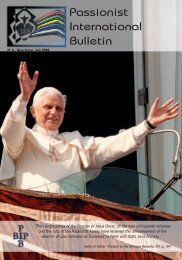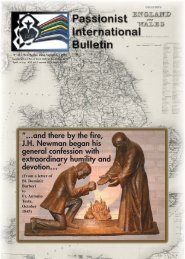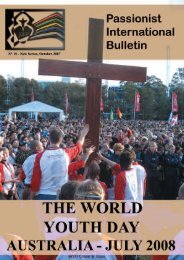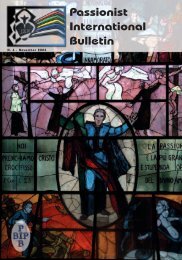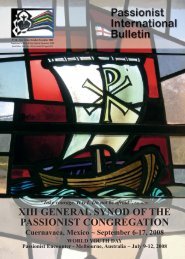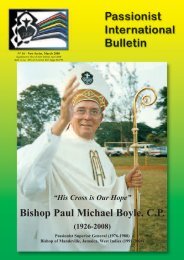the curia informs - Passio Christi
the curia informs - Passio Christi
the curia informs - Passio Christi
Create successful ePaper yourself
Turn your PDF publications into a flip-book with our unique Google optimized e-Paper software.
WITNESSES<br />
FR. FABIANO GIORGINI, C.P. (PIET):<br />
“ONE OF THE MOST BRILLIANT STARS<br />
OF THE PASSIONIST FIRMAMENT”<br />
Fr. Tito Paolo Zecca, C.P. (PIET)<br />
The life and <strong>the</strong> work of Fr. Fabiano Giorgini,<br />
who died on <strong>the</strong> evening of 28 April 2008, in<br />
<strong>the</strong> Generalate Community of Sts. John and<br />
Paul in Rome at <strong>the</strong> age of 79, was a true and exemplary<br />
expression of <strong>the</strong> fact that, rigorous dedication<br />
to studies and <strong>the</strong> attainment of academic degrees, is<br />
in no way incompatible with religious life. On <strong>the</strong><br />
contrary, it increases and enriches it and makes it<br />
more fruitful. Fr. Fabiano spent his vowed life entirely<br />
at <strong>the</strong> service of <strong>the</strong> Church and of <strong>the</strong><br />
Congregation. Until <strong>the</strong> very end, his life that was<br />
characterized by daily dedication to prayer and work,<br />
to <strong>the</strong> numerous and often demanding responsibilities<br />
and tasks that he accepted, as well as to <strong>the</strong> numerous<br />
works that he published. He willingly accepted<br />
responsibilities and tasks in a complete spirit of service.<br />
He sacrificed his time and energy researching<br />
history and spirituality, disciplines to which he dedicated<br />
himself early in life and which comprised <strong>the</strong><br />
greater part of his industrious life.<br />
He left us a biographical record of his life in which<br />
he meticulously lists his life curriculum including<br />
positions that he held, as well as his works and his<br />
cultural activities.<br />
In this<br />
article we will<br />
review <strong>the</strong><br />
principal phases<br />
of his life,<br />
while trying to<br />
present an indepth<br />
and articulated<br />
study of<br />
one of <strong>the</strong> central<br />
and most<br />
outstanding<br />
figures of <strong>the</strong><br />
cultural development<br />
of <strong>the</strong><br />
<strong>Passio</strong>nist<br />
Congregation<br />
during this<br />
recent period of<br />
history.<br />
Fabiano<br />
Giorgini was<br />
born on 2<br />
February 1929<br />
in Castelbasso<br />
General Chapter, Rome - 1964 in <strong>the</strong> Teramo<br />
Community of Sts. John and Paul, 2008<br />
province of Italy. Since he was born on <strong>the</strong> feast of<br />
<strong>the</strong> Presentation, he was baptized “Candeloro”<br />
(Candle Mass), a name that was later changed to<br />
“Fabiano” at his Vestition in September, 1944, in <strong>the</strong><br />
midst of <strong>the</strong> World War. After his undergraduate,<br />
Philosophy and Theology studies that took place<br />
between 1945 and 1952, he was ordained to <strong>the</strong><br />
priesthood at <strong>the</strong> Shrine of St. Gabriel (Teramo) on<br />
27 April in that same year <strong>the</strong> Servant of God, Bishop<br />
Stanislao Battistelli, CP, <strong>the</strong> bishop of Teramo-Atri.<br />
From 1952 to1956 Fabiano completed his studies<br />
for a Doctorate in Church History at <strong>the</strong> Pontifical<br />
Gregorian University, defending his <strong>the</strong>sis, which<br />
was later published, on <strong>the</strong> “Maremma” region of<br />
Tuscany in Italy during <strong>the</strong> 18 th century. He also took<br />
courses in liturgy, archeology and Patristics because<br />
he was being prepared for formation work with <strong>the</strong><br />
Theology students.<br />
In <strong>the</strong> summer of 1956 he began to assume assignments<br />
that entailed great responsibility. These were<br />
to leave an indelible imprint not only on <strong>the</strong> history<br />
of <strong>the</strong> Congregation, but also on o<strong>the</strong>r religious institutes.<br />
Below are some excerpts from this long list<br />
which he himself composed:<br />
“July, 1956, Fr. General, Malcolm La Velle<br />
32<br />
July 2008 - PIB n. 17



